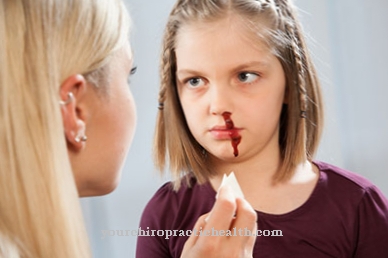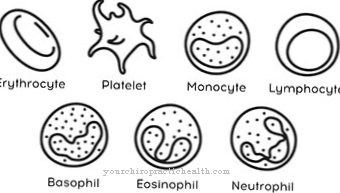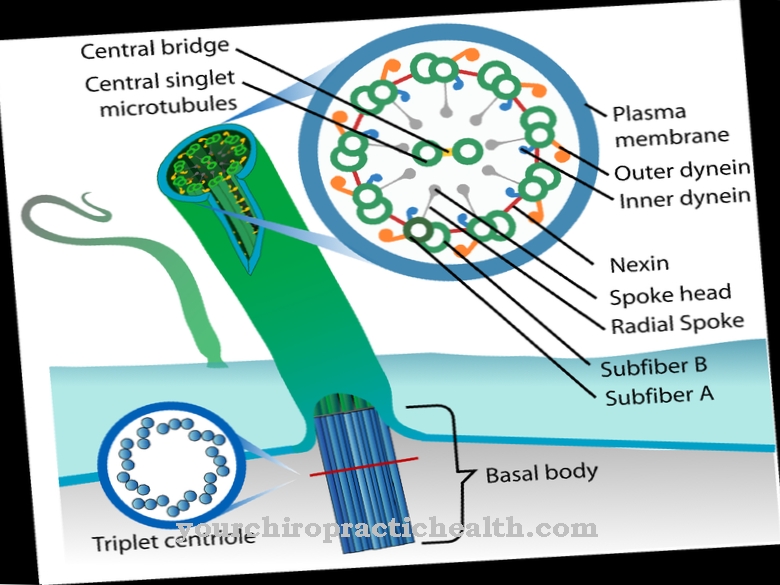The typical tortuous lesions of the Hookworm disease are appropriately called Skin mole designated. Fortunately, the extremely unpleasant disease has a good chance of recovery and can be avoided with a little caution.
What is hookworm disease?

© timonina - stock.adobe.com
Hookworm disease is caused by different species of hookworm larvae. The most common pathogens are the species Necator americanus, Ancylostoma duodenale, both of which only occur in humans, and Ancylostoma brasiliense, the dog hookworm.
Other names for the disease are skin mole, creeping eruption, pit disease, ankylostomiasis and larva migrans. It is one of the most common skin diseases in tropical and warm areas. Hookworms live in Asia, Africa, the Caribbean and Central and South America. The worms can also occur in the Mediterranean region when it is very hot.
The disease was first mentioned in writing in 1874, and in 1928 it was assigned to specific pathogens. The skin mole is particularly widespread among mine and tunnel workers, which is why it is considered an occupational disease for them.
causes
When hookworm larvae dig into a person's skin, hookworm disease develops. The infection usually occurs when a person walks barefoot on a floor that is contaminated with animal and human droppings infected with hookworms, for example on a beach.
Sick animals and humans excrete hookworm eggs with the droppings, which develop into larvae within a few days. These can survive two to three weeks without a host. The disease can also be triggered by foods contaminated with hookworms. But this case is rather rare.
Human-to-human transmission can be ruled out. Skin moles are changes in the skin that form when the larvae crawl under the skin.
Symptoms, ailments & signs
Just a few hours after the larvae have penetrated the skin, hookworm disease and skin moles can become noticeable through reddening and itching. If the hookworm larvae migrate into the lungs or the larynx, those affected feel the urge to cough or vomit, hoarseness and shortness of breath.
A colonization of the digestive tract becomes noticeable about one to four weeks after the infection through nausea, vomiting, abdominal pain, loss of appetite and flatulence; these symptoms are usually accompanied by bloody, slimy diarrhea.
A severe infestation can also lead to anemia, which is characterized by general weakness, decreased performance, concentration disorders, headaches and noticeable pale skin. Other symptoms can include hair loss and brittle nails.
In general, the hookworm disease weakens the body's defense system and makes it more susceptible to infections. Due to the protein loss associated with the disease, more water is often stored in the tissue (edema formation).
The skin mole released by the larvae of dog and cat hookworms remains close under the skin without penetrating into deeper organs. In the initial stage, the parasites cause quite unspecific skin changes such as redness and swelling. When the larvae begin their migration, their tunnels become visible in the form of red, winding lines, which can lengthen by about three centimeters per day. The associated itching is described as very strong to almost unbearable.
Diagnosis & course
The diagnosis is usually made quickly due to the typical skin changes. They are tortuous, reddish, thin passages that form under the skin. An examination of the stool can also reveal the hookworm's eggs under a microscope.
First of all, there is severe itching at the points of the skin changes, especially at the entrance gate of the larva. After the larvae have buried themselves under the skin, they reach the lungs and intestines via the bloodstream. Pathogens in the lungs trigger strong coughing stimuli. In the intestine, the larvae begin to develop into adult worms. It takes about a month.
The larvae attach themselves to the mucous membrane of the small intestine and suck up blood, which leads to severe blood loss and possibly even anemia. One to four weeks after infection, other symptoms such as nausea and vomiting, abdominal pain, flatulence, slimy-bloody diarrhea, loss of appetite and, in particularly severe cases, signs of bronchitis occur.
The larvae of the dog hookworm cause very itchy skin irritations, but they disappear again after a few weeks because they cannot survive in human skin.
Complications
In most cases, these diseases result in very unpleasant complaints on the skin, which can severely limit the patient's life and reduce the quality of life. In most cases, itching and redness will develop on the skin. These can have a negative impact on the patient's aesthetics and lead to reduced self-esteem or inferiority complexes.
Furthermore, anemia occurs, which has a very negative effect on the patient's health. Those affected suffer from severe abdominal pain, vomiting and nausea. It is not uncommon for diarrhea and flatulence to occur, with bloody stool often triggering panic attacks. The patients also suffer from a loss of appetite and can therefore show symptoms of deficiency.
If the pathogens also spread to the lungs, this can lead to a strong cough and inflammation of the airways. As a rule, these diseases can be treated relatively easily, so that there are no further complications and complaints. Medicines are mainly used here. Life expectancy is not reduced with successful treatment.
When should you go to the doctor?
If you notice any swelling, ulceration, or bumps on the skin, you may have a skin mole. A doctor's visit is advisable if the symptoms persist longer than usual or if further symptoms occur. If symptoms such as itching, discoloration of the skin or open wounds arise, medical advice is required. At the latest when inflammation occurs, the person affected should go to the family doctor. This can diagnose the hookworm disease and initiate further measures.
Concomitant symptoms such as diarrhea, nausea and vomiting require medical care if they persist for a period of several days or weeks. Serious complications such as persistent abdominal cramps, severe gas or a high fever must be clarified immediately. The same applies to lesions under the feet, accumulation of blood in the stool or dysfunction of the limbs. If the symptoms mentioned occur after contact with a possibly infected animal or after visiting a beach, a skin mole is suspected. In this case it is best to speak to your family doctor.
Doctors & therapists in your area
Treatment & Therapy
The hookworm disease can be treated well with anti-worm drugs. Ivermectin, albendazole and thiabendazole have proven to be effective active ingredients. They are applied topically or taken orally, depending on where the larvae are located.
Oral ingestion is only carried out if there is no improvement after a week of external treatment, as it is associated with many side effects. The anti-worm drugs paralyze the muscles of the larvae so that the body's immune system can fight and eliminate them more easily.
Severe accompanying complaints such as diarrhea and vomiting can also be relieved with appropriate medication. Cooling and soothing creams and ointments reduce the itching. Surgical measures or freezing have proven to be ineffective.
Outlook & forecast
The prognosis for hookworm disease and skin moles are favorable. Most patients heal spontaneously after a few days or weeks. The symptoms heal completely. Consequences or impairments are normally not to be expected.
More than 80% of the pathogens die independently if the patient's immune system is intact and are then transported out of the organism. Treatment often consists of symptomatic care for the person affected, as the pathogens have already been switched to inactive by the body's own defense system and are no longer a threat.
Hookworm disease can lead to serious and life-threatening complications in some risk groups during the course of the disease.Children in particular must receive adequate medical care if they have a high level of blood loss. They are at an increased risk of mortality if left untreated. In addition, there is a risk of developing further infections, which must be minimized.
If there are further illnesses, the otherwise good prognosis worsens considerably. The hookworm disease and the skin mole demand many resources from the organism, so that the patient experiences a significant deterioration in the general state of health in the event of a further infection. In severe cases, the internal forces are insufficient and there is permanent impairment or a shortening of the existing life expectancy.
prevention
There is currently no vaccination against hookworms, but it is in the development phase. However, there are a few measures to prevent hookworm disease: Anyone who is in a tropical or hot region should not walk barefoot but wear sturdy shoes. Documents and loungers on beaches could be contaminated with animal or human droppings and should be avoided.
Other dangerous places are playgrounds and sandpits, as they could be contaminated with animal feces. They should therefore be cleaned regularly. Regular and careful deworming and delousing of pets is also one of the preventive measures. Those who are already infected should only use toilet facilities and not defecate outdoors.
Aftercare
As a rule, aftercare is not required when treating hookworms in the gut. They respond well to drug therapy and die quickly. The situation is different, however, with hookworms, which have not taken the usual route into the intestine but have established themselves in the skeletal muscles. The active ingredient often does not reach these sufficiently, they survive and continue their journey into the intestine.
Once there, they cause the typical symptoms such as fatigue, loss of appetite, abdominal pain, bloated stomach or slimy-bloody diarrhea. Sufferers should take the occurrence of such symptoms seriously and contact their doctor about re-therapy.
A nutrition-based parasite cure can be carried out during or after therapy. The renunciation of sugar and carbohydrates lets parasites and intestinal fungi literally starve to death. Colon cleansing with subsequent colon cleansing can also be carried out after a treatment. A stool sample is used in the laboratory to determine the composition of the intestinal bacteria and the intestinal flora is built up through the targeted intake of certain bacteria.
An infestation with skin moles, more precisely the hookworm larvae, can lead to serious side effects in the course of treatment. Those affected can relieve the itching of the larval ducts under the skin with antihistamines and must contact a doctor immediately if symptoms such as diarrhea, vomiting or discomfort occur.
You can do that yourself
Patients with hookworm disease and skin mole follow the directions given by their doctor. Those affected counter the various complaints of the disease with adapted measures, whereby a prior agreement with the medical care staff is advisable.
First of all, those affected try to resist the unpleasant itching. To support this, patients avoid sweaty activities and irritating cosmetic products. Whenever possible, people limit the use of cosmetics on the skin during treatment.
Since those affected often suffer from nausea and vomiting, a diet tailored to the symptoms is followed. At best, the diet is easy to digest and without food that is irritating to the stomach. In the case of gastrointestinal symptoms, the patients allow themselves physical rest and pay more attention to the hygiene of the food they eat.
In some cases, affected patients experience coughing problems, and it is helpful to stop or at least reduce smoking while being treated for the disease. Avoid infection with other respiratory diseases. The sick people take the medication prescribed for the treatment of hookworm disease and skin mole and adhere to the doctor's instructions regarding time and dosage.


.jpg)
























